Carpal Tunnel Syndrome
On this page
- What is carpal tunnel syndrome?
- How does carpal tunnel syndrome develop?
- What are the occupational factors of carpal tunnel syndrome?
- What are the non-occupational factors of carpal tunnel syndrome?
- What are the symptoms of carpal tunnel syndrome?
- How is carpal tunnel syndrome recognized?
- How is carpal tunnel syndrome treated?
- How can we prevent carpal tunnel syndrome?
What is carpal tunnel syndrome?
Back to topCarpal Tunnel Syndrome is a condition affecting the hand and wrist. The carpal tunnel is a space in the wrist surrounded by wrist bones and by a rigid ligament that links the bones together (see Figure 1).
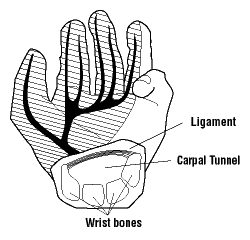
Through this small tunnel pass the flexing tendons of the fingers and thumb as well as the median nerve (see Figure 2). These tendons attach muscles to bones in the hand and transfer the movement of the fingers from muscles to bones. The median nerve carries signals from the brain to control the actions of the fingers and hand.
It also carries information about temperature, pain, and touch from the hand to the brain and controls hand sweating.
The thumb, index, middle and ring fingers are under the control of the median nerve (see Figure 2).
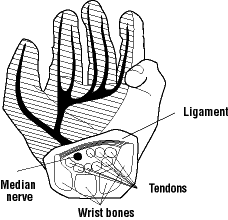
In the carpal tunnel, the tendons of the fingers surround the median nerve. The swelling of the tendons reduces the space in the tunnel and squeezes the median nerve, which is softer than the tendons. Pressure on this nerve can injure it.
Such injury results in sensations of numbness, tingling, pain, and clumsiness of the hand. This combination of symptoms is called carpal tunnel syndrome. People with carpal tunnel syndrome experience difficulty in performing tasks such as unscrewing bottle tops, fastening buttons, or turning keys.
How does carpal tunnel syndrome develop?
Back to topAny action that squeezes or irritates the median nerve may cause carpal tunnel syndrome.
For example, bending the wrist or moving the fingers brings muscles and tendons into action. When a person bends a finger, the tendon moves about two inches. The tendons of the hand are encased in sheaths, or sleeves through which the tendons slide. The inner wall of the sheaths contains cells that produce a slippery fluid to lubricate the tendons. Lubrication is essential for the normal and smooth functioning of the tendons. With repetitive or excessive movement of the hand, the lubrication system may malfunction. It may not produce enough fluid, or it may produce a fluid with poor lubricating qualities. Failure of the lubricating system creates friction between the tendon and its sheath, causing inflammation and swelling in the tendon area. In turn, the swelling squeezes the median nerve in the wrist or carpal tunnel. Repeated episodes of inflammation cause fibrous tissue to form. The fibrous tissue thickens the tendon sheath and hinders tendon movement.
What are the occupational factors of carpal tunnel syndrome?
Back to topThe National Institute of Neurological Disorders and Stroke (USA) indicates that carpal tunnel syndrome is "often the result of a combination of factors that increase pressure on the median nerve and tendons in the carpal tunnel, rather than a problem with the nerve itself".
Carpal tunnel syndrome has been associated with certain tasks, including:
- Repetitive hand motions.
- Awkward hand positions.
- Strong gripping.
- Mechanical stress on the palm.
- Vibration.
Those workers performing assembly line work - including manufacturing, finishing, cleaning, and meat/poultry/fish packaging - commonly report this injury. Cashiers, hairdressers, knitters or sewers are examples of people whose work-related tasks involve the repetitive wrist movements associated with carpal tunnel syndrome. Bakers who flex or extend the wrist while kneading dough and people who flex the fingers and wrist in tasks such as milking cows, using a spray paint gun, and hand-weeding are other examples. Excessive use of vibrating hand tools may also be related to carpal tunnel syndrome.
A possible link between carpal tunnel syndrome and computer mouse use is uncertain. Note that the repetitive motions required for keyboard work and the use of a computer mouse may be related to the development of other injuries.
The following table lists tasks and related occupations associated with carpal tunnel syndrome. This list is not complete.
| Table 1 Job tasks and occupations associated with carpal tunnel syndrome | |
|---|---|
| Job Tasks | Occupations |
| Grasping and tugging fabric, pulling cloth | Production sewer, tailor, garment worker/stitcher |
| Milking cows | Agricultural worker |
| Handling objects on conveyor belts | Assembly-line worker |
| Pushing down a ratchet, using a screwdriver | Mechanic |
| Hand weeding | Gardener |
| Using spray gun | Painter |
| Knitting | Crafts-person |
| Scrubbing | Janitor, personal support worker, kitchen and restaurant worker |
| Playing stringed instruments with a bow | Musician |
| Using laser scanner at checkout | Cashier |
| Cutting, de-boning | Butcher/poultry-processing worker |
| Assembling small parts | Electronic industry worker |
| Turning keys | Locksmith |
| Wearing poorly fitting gloves which apply external pressure | Agricultural workers, mechanics, factory workers, those working in cold temperatures |
| Pressing a tool into the palm | Painter, carpenter, stablehand |
| Pounding safety lever or stamping machine | Receipt processor |
| Using air-powered hand tools | Assembly worker, construction worker |
Some studies show that psychosocial factors (such as stress) can also contribute to the development of carpal tunnel syndrome.
What are the non-occupational factors of carpal tunnel syndrome?
Back to topCarpal tunnel syndrome is associated with several diseases and situations. They are:
- Inflammatory conditions, such as arthritis or gout, that affect the lining around the tendons.
- Nerve-damaging conditions, such as diabetes.
- Anatomical factors such as individuals who have small carpal tunnels or have experienced wrist fractures and dislocations.
- Medicines, such as anastrozole (a medicine used to treat breast cancer).
- Body fluid changes, such as those common during pregnancy and menopause.
- Obesity.
- Other medical conditions, such as thyroid disorders, kidney failure, or lymphedema (swelling of tissue).
All these diseases and situations increase the volume of the contents of the carpal tunnel, resulting in compression of the median nerve.
Women are more likely than men to develop carpal tunnel syndrome, and this difference could be because a women's carpal tunnel is generally smaller than those of men.
What are the symptoms of carpal tunnel syndrome?
Back to topThe typical symptoms of carpal tunnel syndrome are tingling, numbness, or pain of the thumb, and of the index, middle, and ring fingers. Symptoms may awaken the affected individual at night but are often relieved by shaking, hanging, or massaging the hand. Pain may also involve the arm and the shoulder. Weakness and loss of manual dexterity occur in more advanced cases, causing difficulty with pinch and grasp. The person may drop objects or be unable to use keys or count change with the affected hand. The skin may dry because of reduced sweating.
How is carpal tunnel syndrome recognized?
Back to topPeople who suspect carpal tunnel syndrome often consult a doctor. The evaluation of occupational carpal tunnel syndrome includes identifying workplace risks. Evaluation begins with a discussion about the person's employment and requires a detailed description of all the processes involved in a typical day's work. It also requires consideration of the frequency, intensity, and duration of each task performed at work. Diagnosis of carpal tunnel syndrome is confirmed by performing certain tests to detect damage to the median nerve. Some of these tests are:
- Tinel's test - The physician taps the median nerve at the wrist. A tingling response in one or more fingers indicates damage to the median nerve.
- Phalen's test - The patient puts the backs of the hands together and bends the wrists for one minute. Tingling of the fingers indicates damage to the median nerve.
- Electromyography - Electrodes are placed on the forearm, and electrical current is passed through the patient. Measurements on how fast and how well the median nerve transmits messages to muscles indicate if there is damage to this nerve.
How is carpal tunnel syndrome treated?
Back to topWhen symptoms of carpal tunnel syndrome are mild or likely to be temporary, treatment includes rest, anti-inflammatory drugs, cold packs, or a splint. Even if a patient wears a splint that has been prescribed, they should avoid the activities that cause or aggravate the injury. Where this is not possible, patients should wear the splint after work, particularly during sleeping hours.
Specific exercises supervised by a physical or occupational therapist can be beneficial.
Surgery may be necessary if the symptoms are severe and if the other measures do not provide any relief. However, surgery should not be the first choice for treatment. Even after surgery, some patients may still have problems.
It is best to seek a diagnosis and treatment as early as possible to avoid permanent damage to the median nerve.
How can we prevent carpal tunnel syndrome?
Back to topPrevention of carpal tunnel syndrome may involve redesigning workstations, tools, or the job, and educating workers. Appropriate workstation design reduces awkward wrist positions and minimizes the stressful effects of repetitive motions. Awkward positions can originate from unsuitable workstation designs that do not take into account the size and proportions of the human body. Workstations should be adjustable and should accommodate a vast majority of people who work in that area.
It is important to redesign work methods. For example, using an adjustable fixture to hold an electrical housing, as Figure 3 shows, reduces wrist flexion.
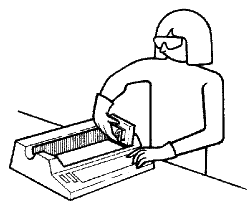
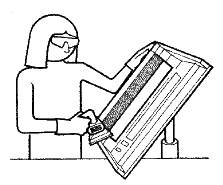
Figure 3 - Examples of an adjustable fixture
(B) that reduces the wrist flexion shown in (A)
Redesigning tools is also important. One study in a poultry processing plant found that workers who used standard knives were prone to carpal tunnel syndrome. When the workers started using knives with bent handles, they no longer needed to bend their wrists while cutting the meat (see Figure 4). This change significantly reduced the occurrence of carpal tunnel syndrome.
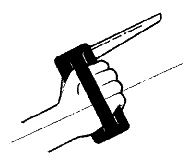
Good job design minimizes awkward wrist positions and tasks with repetitive motions. Job design includes the following:
- Analysis of the sequence of the tasks to allow changes in body position.
- Work-rest schedule to relieve muscles and tendons from mechanical stress.
- Job enlargement to avoid monotonous and repetitive patterns of work.
- Rotation of tasks to move workers from one job to another.
Worker training should aim to reduce the number and types of awkward wrist postures and the number of repetitive motions. Informing workers about the risk factors that can contribute to carpal tunnel syndrome is important.
To limit the effects of a physically stressful job, employers should work closely with workers. This action is achieved by implementing worker training and job rotation, and by matching workers to job assignments.
- Fact sheet last revised: 2024-05-22

